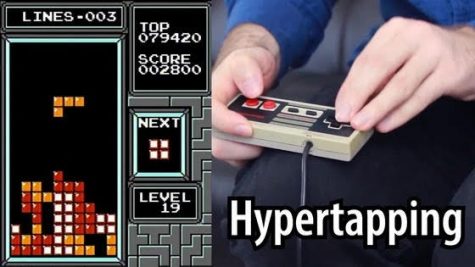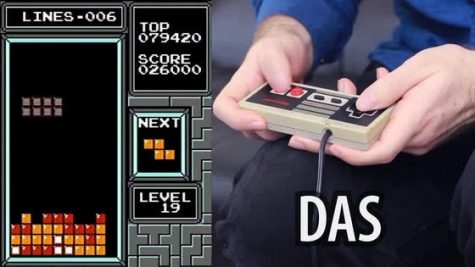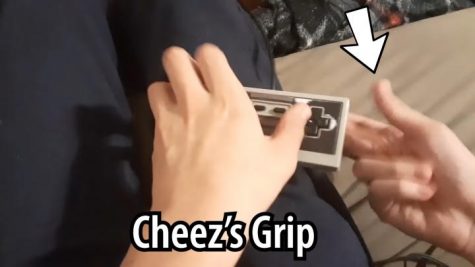After 37 years, Tetris has been revolutionized with new a game-breaking strategy
After 37 years, NES Tetris player Cheez has come up with a revolutionary Tetris strategy known as rolling. Nobody could have predicted the changes this would have on the competitive Tetris scene.
Carter Thrash (Screenshot from https://www.youtube.com/watch?v=n-BZ5-Q48lE)
NES Tetris has a new game-breaking strategy: rolling.

In CTWC (Classic Tetris World Championship), players go head to head in NES Tetris and compete to see who can get the highest score before topping out. Most players have a hard time deciding where the pieces should go. For top players, this is almost second nature. The game runs at 60 frames per second. Pieces fall one block every certain number of frames. As the level increases, the frames between block movements decreases. Competition matches start on level 18 instead of level 1. On this level, the pieces move down at a rate of 1 block per 3 frames. It takes 1 second (or 60 frames) for the piece to fall from the top of the screen to the bottom.
From levels 19-28, the pieces speed up and move at a rate of 1 block per 2 frames (two-thirds of a second for a piece to fall from the top of the screen to the bottom). Despite being a difference of only one frame, this is a 50% increase in speed. Top players are typically okay with this speed, but they have to be on their feet at all times and stay prepared for any misdrops or to correct any mistakes.
Once players hit level 29, the game reaches it’s highest possible speed: 1 block per 1 frame. That’s twice the speed as the previous levels. A piece on level 29 falls from the top of the screen to the bottom in just a third of a second! For comparison, the average human reaction time is about a quarter of a second. For a long time, this speed is where even the best of the best players just gave up. The problem for top players was not deciding where the pieces needed to go, it was physically pressing the right or left buttons fast enough to get the pieces where they needed to go. Level 29 is often referred to as the “kill screen.” For 36 years, level 29 was the limit.
For nearly all of its history, NES Tetris has been split between two playstyles. One is known as DAS (Delayed Auto Shift). DAS involves holding down right or left to make the pieces move quickly. DAS moves a piece over one block every 6 frames (or 10 blocks per second). This is pretty fast, but on the kill screen, where you have just a third of a second, it’s not fast enough. Another strategy known as hypertapping has recently become popular among younger players. As the name might indicate, it involves pressing the right or left buttons over and over again as fast as possible. Over the past few years, hypertappers have made up more and more of the CTWC finalists.


Most notably, a 16 year old hypertapper named Joseph Salee defeated seven time CTWC champion, Jonas Neubauer in the 2018 CTWC finals. Unlike DAS, hypertapping has no speed limit. Players like Joseph are capable of pressing the right or left buttons over 12 times per second. This has allowed a few players to play on the kill screen with some success. The main problem with hypertapping is the strain it puts on your hands. Elite Tetris player, Sam Finch comments, “I’m a hypertapper, I like it. But since I have the genetic disadvantage of being a slow tapper, I look forward to a future where we may have some sort of butterfly technique.” Butterflying refers to a mouse-clicking technique many gamers use to achieve high click speeds. It involves alternating between two fingers as you click. 2020 CTWC finalist, PixelAndy comments, “Hypertapping is definitely the new way to play, and I think it makes for better scoring games.” As Finch and Andy makes clear, the consensus among the Tetris community is that an ideal tapping strategy would be as fast as hypertapping, yet as easy to do as DAS, and recently, this is exactly what was discovered.
Renowned bass player and Tetris enjoyer, Rob Scallon, was playing Tetris one day with CTWC champion, Jonas Neubauer. Rob couldn’t help but feel like there had to be a better alternative to hypertapping. Being a bass player, he used methods of dividing the work to play multiple notes with minimal effort. His instinct was to try out a rolling technique where he rolled multiple fingers over the D pad. His strategy didn’t work very well because of how small the D pad is, but he laid the groundwork for the one who did.

Cheez was a relatively unknown Tetris player. After watching a YouTube video on button mashing, he learned you could double your tap speed on a Gamecube controller by pushing the controller into another finger between button presses. This inspired him to develop a technique called rolling. This involves rolling multiple fingers over the back of the controller, pushing the controller into your finger which is resting on the D pad. Using this technique, Cheez was able to get speeds of over 20 button presses per second! After hours upon hours of practice, Cheez has mastered the rolling technique and has shattered the highest score world record, 100 line sprint world record, the record for the most points earned on the kill screen, and many, many more.
Many players have started rolling and will likely be using it in the 2022 CTWC. The battle between DAS and hypertapping has been an interesting to watch over the past few years, but it’s hard to say what will happen now that the kill screen barrier has been broken.




